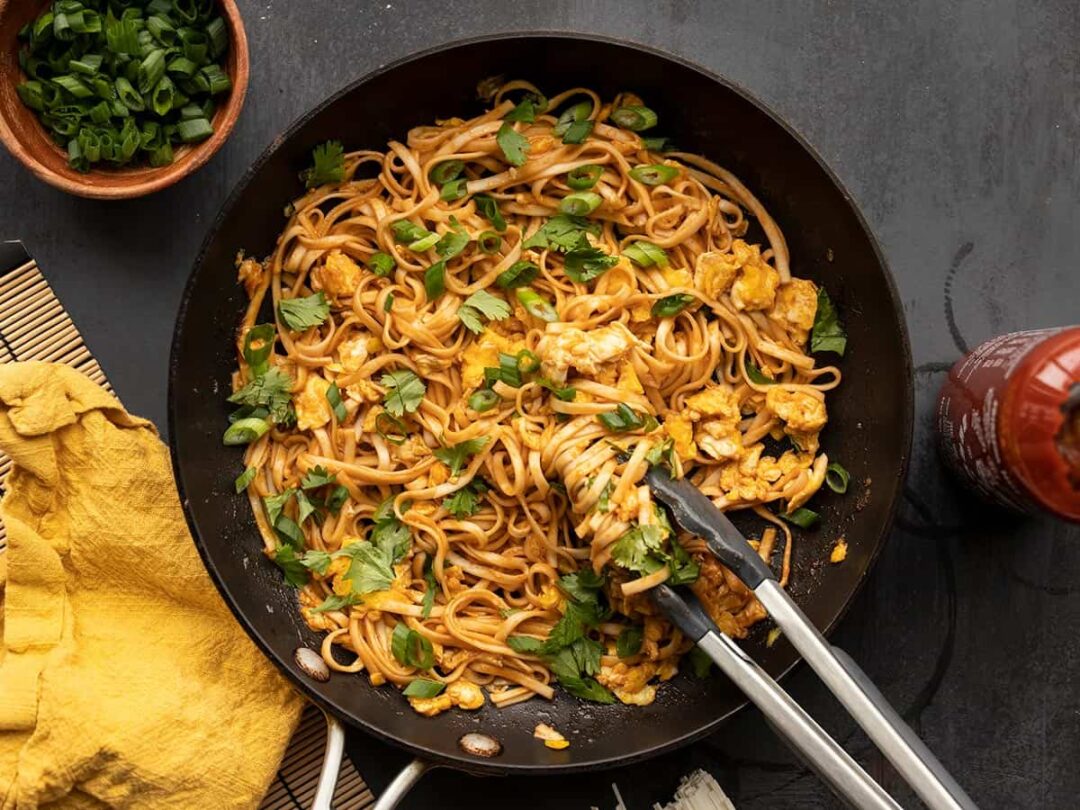Trying to figure out how to adequately describe this Thai Red Curry Vegetable Soup to you, I’m sitting here staring at a blank screen.
It may be wise for me to tell you that I wanted to skip the bowl and just eat it straight from the pot using that giant ladle as my spoon, instead of using the bowl.
There was a time I was almost tempted to tell my boyfriend I did not prepare anything today so that I could hide the soup and eat it all by myself (no, that was just me being mean).
As for what I am trying to say, Thai Curry Vegetable Soup is awesome. I mean, seriously awesome. Combined with its simplicity and ease of preparation, I think I will be making this about every week. Although it’s probably not a good idea for me to eat that much coconut milk, I’m sure I’ll find a way to justify it.
Because of the deliciousness and ease of making this curry, Apronese shares the full recipe and step-by-step instructions below for everyone to make.

Thai Red Curry Paste: What Is It?
Usually, Thai red curry paste is made from a mix of red peppers, chiles, ginger, garlic, and other spices. Thai red curry paste is not to be confused with Indian curry powder, which is a mix of different spices, and is usually sold in the form of powder, rather than paste.
Thai red curry paste is a versatile ingredient that can be used for soups, stir-fries, sauces, and much more.
Thai Red Curry: How Hot Is It?
There is a difference in the level of spice in Thai red curry soup depending on the brand of Thai red curry paste used. I used Thai Kitchen brand, which is very common in U.S. grocery stores, which is not very hot. While the green Thai curry paste is quite a bit hotter than the red Thai curry paste.
Vegetables Can Be Customized
As an aside from the fact that I went to an Asian market yesterday, where I bought the ingredients for the Thai Curry Vegetable Soup (at really amazing prices, I might add), you can still make the Thai Curry Vegetable Soup if you don’t have access to those vegetables.
I think the best thing about this Thai Curry Vegetable Soup is that it is so versatile that just about any vegetable you choose can be used, although I try to include some sort of leafy green vegetable.
As well as the above listed vegetables, there are many more that would be great choices as well, such as spinach, kale, collard greens, chard, mushrooms, bean sprouts, snow peas, carrots, and red peppers.
Vegetarianize It
You can easily add meat to this soup, if you want to. I made a vegetarian version today (minus the fish sauce, anyway), but it’s easily adapted for vegetarians as well.
Adding some shredded chicken from the rotisserie, or cooking some chicken pieces with the Thai curry paste at the beginning, is what you need to do. You can add shrimp at the end if you want, but you will need to simmer it for a few minutes until the shrimp is pink.
Noodle Options
There is pretty much unlimited customization when it comes to the noodles. You can skip them entirely if you want, or use a brick of cheap-o ramen if that happens to be what you have in the house. It will still taste amazing, no matter what you do..

Thai Red Curry Vegetable Soup
The Thai Curry Vegetable Soup recipe is packed with vegetables, a spicy Thai flavor, and a creamy coconut milk base that is ready for consumption in about 30 minutes.
Author: Beth
Servings: 4 (about 2 cups each)
Ingredients
- 2 Tbsp neutral cooking oil* ($0.04)
- 2 cloves garlic ($0.16)
- 1 Tbsp grated fresh ginger ($0.05)
- 2 Tbsp Thai red curry paste ($0.62)
- 1 small sweet potato (about 1 lb.) ($1.61)
- 1 bunch baby bok choy ($0.55)
- 4 cups vegetable or chicken broth ($0.52)
- 1 13oz. can coconut milk ($1.29)
- 1/2 Tbsp fish sauce ($0.07)
- 1/2 Tbsp brown sugar ($0.02)
- 3.5 oz. rice vermicelli noodles ($0.39)
Garnishes (optional)
- 1/2 red onion ($0.29)
- 1 lime ($0.17)
- 1 handful fresh cilantro ($0.17)
- Sriracha to taste ($0.15)
Instructions
- It is best to prepare the vegetables and garnishes for the soup in advance so they are ready to serve when required. You should mince the garlic and grate the ginger with a small-holed cheese grater before adding them to the soup. Peel and dice the sweet potato into 1-inch cubes. Wash the bok choy well, and then chop the stalks into 1-inch strips, separating them from their delicate green ends. Slice the red onions thinly and chop the cilantro roughly.
- To make the curry paste, add the garlic, ginger, and coconut milk to a large soup pot along with the cooking oil. Sauté for about 1-2 minutes, or until the garlic, ginger, and coconut milk are warm.
- A pot should now be filled with the diced sweet potatoes and chopped bok choy stalks (save the leafy green ends for later) along with the chicken or vegetable broth. The sweet potatoes need to be cooked until they are completely tender, so bring the pot up to a boiling boil over medium-high heat, then reduce the heat to low and simmer for five to seven minutes.
- During the process of simmering the soup, heat up a small pot of water for the vermicelli. Once it comes to a boil, add the vermicelli to the boiling water and let it boil for 2-3 minutes, or until it becomes tender. Drain the rice noodles in a colander and set them aside.
- Taking the sweet potatoes from their skins and placing them into a bowl, shred them with a fork and add them to the soup along with the coconut milk, fish sauce, and brown sugar. Stir, taste and adjust the amount of fish sauce or brown sugar if necessary. Finally, add the bok choy greens and allow them to wilt in the hot soup.
- The dishes are served in four bowls with rice vermicelli arranged in the middle, topped with carrots and celery, then ladled with the soup and vegetables, then garnished with red onion, cilantro, a wedge or two of lime, and a drizzle of sriracha.
*Any neutral (low-flavor) cooking oil can be used for this purpose, such as vegetable or corn oil, canola oil, sunflower oil, grapeseed oil, or peanut oil.
Nutritional
Serving: 1 Serving ・ Calories: 341.18 kcal ・ Carbohydrates: 55.83 g ・ Protein: 7.93 g ・ Fat: 10.6 g ・ Sodium: 1618.28 mg ・ Fiber: 6.18 g
The nutritional values shown here are only estimates. Please see our nutrition disclaimer .

How to Make Thai Curry Soup – Step by Step Photos

In order to ensure that your vegetables are ready when you need them, you need to prepare them beforehand. I just happened to go to an Asian market the day before, and picked up these Japanese yams, baby bok choy, limes, cilantro, and red onions. In case you need ideas for alternate vegetables, please read over the introduction.

If you do not have sugars, you can also use agave nectar for the Thai Curry Vegetable Soup. Peel, dice, and cut the yam (or sweet potato, either will work well), thinly slice the red onion, wedge the limes, and cut the bok choy into strips.
Be sure to keep the stalk end and the leafy green end separate, as they will be added at different times in the soup.

It’s also important to note that Thai red curry paste is very different from curry powder that is used in Indian cuisine, so you will need to mince two cloves of garlic as well as grate some ginger from the outside.
As I mentioned, if you want to make this soup extra easy you can skip the garlic and ginger, and simply add more Thai red curry paste in place of the garlic and ginger. The soup is a simple, spicy combination of red chilies, garlic, galangal (similar to ginger), lemongrass, and a few other spices.

Adding two or three tablespoons of any neutral cooking oil (like canola, vegetable, peanut, sunflower, grapeseed, avocado), minced garlic, grated ginger, and two spoons of the Thai red curry paste to a large pot, and cooking for 1-2 minutes on medium heat will bring out the aroma and flavor of the garlic, ginger, and curry paste.

I recommend adding the really hard vegetables at this point, and in this case, the yam (or sweet potato) and bok choy stalks to the soup to allow them to soften in the soup as they simmer.

It is important to add four cups of vegetable or chicken broth, place a lid over the dish, and bring the mixture to a boil over medium-high heat. Once it has reached a boil, reduce the heat to low and let it simmer for 5-7 minutes, or until the sweet potato is tender.

It was during the simmering time of the soup that I cooked the rice vermicelli separately (this package contains 3.5 oz). The reason I cooked the noodles separately is that they cook so quickly that they would not overcook when added to the soup.
It may, at some point in the future, be possible for me to add them to the soup at the end and let them soften that way, but today I wanted to be extra certain, so I just cooked them separately.
The noodles are only softened for about 2-3 minutes in boiling water, then they need to be drained in a colander, and then set aside.

I would like to return to the soup pot, once sweet potato cubes have soften to the point where they can be mashed, add a can of coconut milk, which will transform the soup into this delicious creamy goodness.

In addition, 1/2 tablespoon of fish sauce and half a teaspoon of brown sugar should also be added. Just so you know, if you have never used fish sauce, you should know that it is very potent and does not smell very good.
However, because it is used in such small quantities, that does not really translate into the dish in which it is used.
Essentially, fish sauce adds a subtle umami flavor along with a little saltiness to this dish. You can leave it out if you are unable to find fish sauce or if you wish to make this dish vegetarian.
Honestly, I don’t know if you can skip the fish sauce and have the recipe turn out great, but IMHO it will be missing that little something, that authentic flavor that fish sauce gives, and you can probably skip the brown sugar as well if you skip the fish sauce.

It is important to taste the broth when adding the fish sauce and brown sugar, as well as adjust the flavors if needed.
At the end, add the white leaves of the bok choy to the hot soup and let them wilt and simmer in the hot soup (the pot should still be kept on a low heat).

If you would like to serve the Thai Curry Vegetable Soup with rice vermicelli, place some in the bottom of the bowl.

As soon as the soup and vegetables are over the noodles, ladle them over the soup and vegetables.

After that, add the garnishes: thinly sliced red onions, lime wedges, chopped cilantro, and a drizzle of Sriracha sauce as the final touch.

Let’s dig in and see what we can find.

In fact, just try not to die from happiness when you are tasting the most delicious Thai Vegetable Soup you have ever eaten.

Hey, beautiful.
Curry is sure everyone has eaten and experienced the taste, right? What about the Thai red curry that Apronese instructed above, have you tried it yet? Let us know your results in the comments section.






